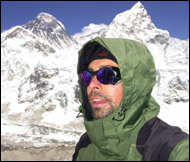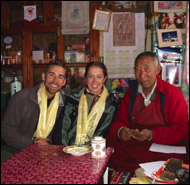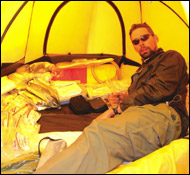

Janis and his wife, Nikki, sit with a Buddhist monk in Pangboche who blessed them before their journey. The scarves they are wearing are called katas and are traditional Nepalese, Sherpa, and Tibetan prayer scarves that are given for good luck and as a blessing.

Beyond Boundaries: On Top of the World
Former Mason student-athlete Janis Tupesis shares his experience as a team physician on Mount Everest expeditions
Janis Tupesis, B.A. Biology '95, recently traveled as lead physician with Team Everest '03, a campaign by the Coalition of Texans with Disabilities. He was part of the group that saw climber Gary Guller become the first one-armed man to climb Mount Everest. Tupesis had accompanied Guller to Everest once before in 2001.
Tupesis, a 2001 graduate of the University of Wisconsin Medical School, is completing his last year of residency training in emergency medicine at the University of Chicago. Before entering medical school, he spent two years at the National Institutes of Health on a predoctoral fellowship studying how the immune system combats cancer. Tupesis talked with Mason Spirit writer Tara Laskowski about his experiences on the mountain, in medical school, and at Mason.
Q: I read that your parents got you interested in climbing and the outdoors. Is this where the appeal to go to Everest came from?
A: When I was growing up in Wisconsin, my family spent a lot of time doing outdoor recreational activities. We were constantly traveling and spent most summers outdoors—hiking, biking, camping, and such. We had been to most of the large national parks before I was out of grade school. I'm not sure if it led to the appeal to go to Everest, but it definitely led me to meet Gary Guller.
Q: Who is Gary Guller, and how did meeting him lead to you to Everest?
A: I met Gary during my second year of medical school. My wife, Nikki [Nicole Jensen, B.A. Biology '94], and I were at an Adventure Travel Expo in Madison, Wis., looking for a safari trip to Africa. Among the many booths was one for Arun Treks and Expeditions, a small high-altitude outfit based in Austin, Texas. Gary, the company's president, had lost his left arm in a climbing accident years before in Mexico. We immediately hit it off and wound up spending an hour or so talking. At the end of our conversation, he asked me, "Are you a doctor?" I was surprised because medical school had not come up in our conversation. I then realized that I was wearing a University of Wisconsin Medical School sweatshirt. He soon asked me to join his 2001 Anything Is Possible Everest expedition as part of the medical staff. It was my first experience with high-altitude climbing and expeditions and was a great learning experience. Gary and I were joined by climbers from Britain, Turkey, and Canada, and another from the United States. Unfortunately, circumstances prevented Gary from reaching the summit, which I'm sure gave inspiration to this year's expedition.
Q: When did you realize that you would be returning to Everest?
A: After the 2001 Everest Expedition, Gary and I kept in touch. In February 2002, I received an e-mail with the subject line reading "Everest 2003???" and I knew that I was heading back. Initially, I did not know the broad scope of the Team Everest 2003 message but soon found out that along with Gary's summit attempt we would be helping a group of disabled athletes trek to Base Camp at 17,800 feet. We would be attempting the first ascent with five men in wheelchairs: two with quadriplegia and three with paraplegia. We also were joined by about 10 others with varying disabilities—from limb amputations to hearing loss to chronic pain. About 70 people were involved with this Challenge Trek, including our Sherpa staff, porters, and guides.
Q: Being a medical resident at the University of Chicago, how were you able to find the time to take this trip?
A: The logistics of being able to go were quite complicated. Still being in my residency, I had to juggle my schedule around. I took all of my vacation time and piggybacked it next to an International Health rotation, which gave me eight weeks off. I have to give many thanks to my fellow residents and colleagues at the University of Chicago Hospitals Section of Emergency Medicine for their help and flexibility.
Q: How do you prepare for such a journey? Can you ever truly be ready for something like Everest?
A: This expedition was much different than the first one I went on. This time, I knew what to expect, and I knew how to train and prepare. For the 2001 expedition, I had no idea of what I faced and probably overtrained a little bit, spending four to six months running, lifting weights, and hiking with as heavy a pack as possible. The thing you don't realize is that when you are at 18,000 feet, you burn more calories than you can possibly consume in a day, so you lose weight regardless of your level of activity. If you are in too good of a shape, you wind up looking like a skeleton. So this time, along with getting into good physical shape, I tried the cheeseburger and beer approach, trying to gain 15 to 20 pounds before I went. In general, being in good physical condition is a must, but people react to altitude differently. Some world-class athletes will suffer altitude-related illnesses, while some self-proclaimed couch potatoes will do just fine.
Q: How high did you go? Were you stationed at Base Camp or did you go higher?
A: Most of the time I was stationed at Base Camp, taking care of the climbers, our Sherpas, and our ancillary staff. During both expeditions, I joined the climbing team going through the Khumbu Icefall, the first part of the climb up to Camp I at 21,000 feet.
Q: Tell me about your duties as the lead physician. What sorts of things did you encounter?
A: My training in emergency medicine suited me perfectly for my role as lead physician for Team Everest '03. In the emergency room, you see the widest variety of clinical problems encountered in all of medicine. The same is true of an Everest expedition. Most people think you only encounter altitude illness, but you also run across simple medical problems such as respiratory tract infections, diarrheal illnesses, and bumps, bruises, sprains, and such. But on this expedition and the one in 2001, we also had instances when people became critically ill.
Q: What were the toughest things you had to deal with?
A: One of the Challenge Trek members with quadriplegia developed a small bowel obstruction—a potentially life-threatening illness—one day before we got to Base Camp. After spending a stress-filled night with him, we had to evacuate him by helicopter back to Katmandu. The next night, another of our climbers developed a severe condition called high-altitude cerebral edema. At such high altitudes, there is functionally less oxygen in the air. Your body's small blood vessels don't like this and start to leak. This fluid fills up your lungs and the extra space in your brain causing it to swell. Again, it is a life-threatening condition, which necessitated us to call in another helicopter from Katmandu.
One of the most interesting experiences occurred on the trek up. We were in a little village called Monjo when a small boy was attacked by a dog. His face was severely lacerated, so we turned one of the small teahouses into a makeshift emergency room. I managed to suture his lip and face back together while 50 people crowded around. Those of us who helped received katas, or Tibetan prayer scarves. For the rest of the day rumors circulated that an American physician was in town, so people were coming to me at all hours of the night with various medical problems. It was truly a great experience.
Q: How did you try to educate the climbers regarding health issues?
A: In regard to climber education, there was very little the climbers I was with didn't already know. They had been climbing for years and had a lot of experience dealing with high-altitude issues. We did have daily health briefings, trying to keep the climbers healthy to give them a better chance at a summit bid. Before they left on their final summit attempt, we practiced with their summit-day medical kits, which included medicine for pulmonary and cerebral edema. They actually practiced giving steroid injections; however, no one wanted to stick themselves so we used apples instead.
Q: What will you remember most about this expedition?
A: Being on an expedition like this changes you in pretty profound ways. Without a doubt, I will remember the courage and dedication exhibited by the 15 plus members of the Challenge Trek team. Over the course of 21 days, they climbed, pushed, pulled, and were carried over the more than 40 miles of single-track trail to Everest Base Camp at 17,800 feet. We showed the world that a person's potential, regardless of his or her ability or disability, is limitless. I encourage everyone to visit the Team Everest '03 web site at www.teameverest03.com for details on the Challenge Trek, our time at Base Camp, and Gary's success as the first man with only one arm to reach the summit on May 23, 2003.
Q: Do you have any aspirations to make it to the top yourself one day?
A: I would be lying if I said that I don't think about it often. Realistically, if I were ever to try, I would have to take a break from medicine and dedicate my life to getting ready. One needs a little more high-altitude experience than I have, including training on such peaks as Aconcagua in Argentina or Denali in Alaska, before attempting a peak such as Everest. Many people think Everest climbers are crazy, and books such as Jon Krakauer's Into Thin Air expose the public to the tragedies that are a daily part of life on Everest. But as British mountaineer Mike Trueman told me on our 2001 Everest expedition, "We come here to live, not to die."
Q: One last question, on a totally different subject, do you have any favorite Mason memories?
A: There are too many to recall. I met my wife and many of my best
friends at George Mason. Both Nikki and I were student-athletes there,
recruited to play volleyball, so many of my best memories are of that.
During my four years on the team, we were ranked among the top 15 teams
in the country and on occasion moved into the top 10. And who can forget
TT Reynolds, Brion's Grille, and Mason Day? It was a great mix of academics,
athletics, and recreation.
